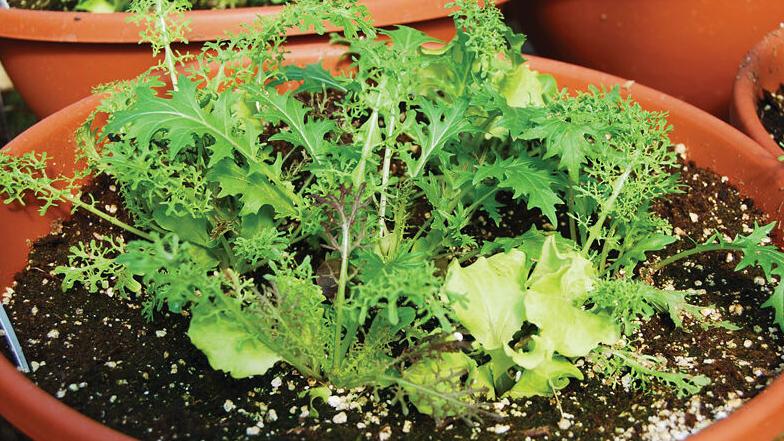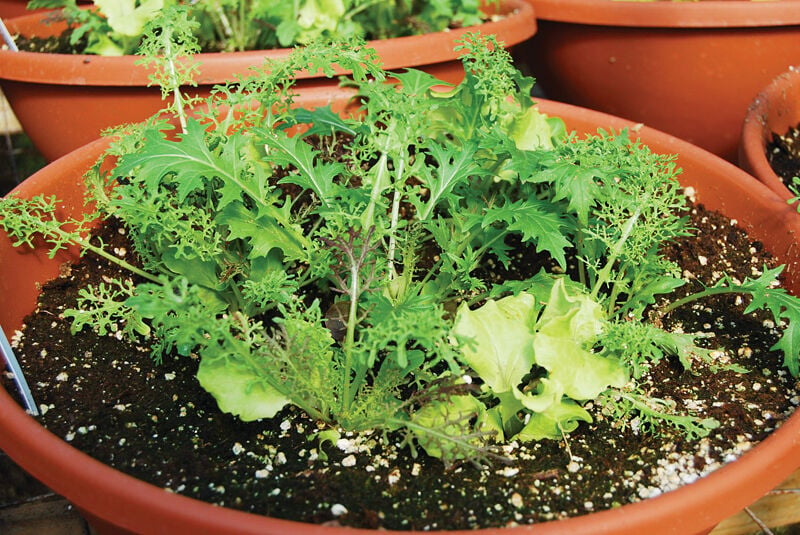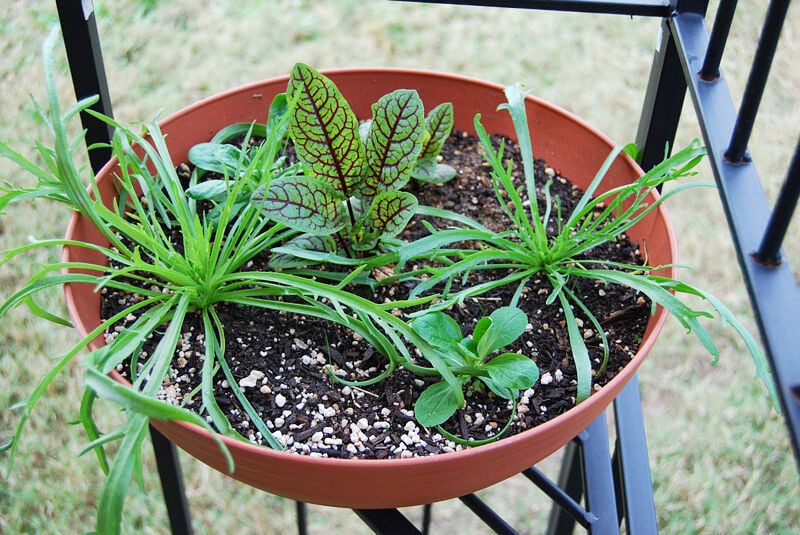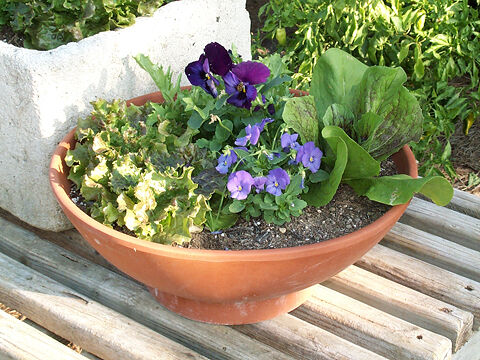
Cool-season container gardens are easy to care for, attractive and can grow some great vegetables in a very small space. They offer versatility and add a unique look to a porch, patio, driveway or balcony. Best of all, containers allow you to grow fresh, healthy salad veggies despite the winter weather, as they are easily moved into a protected location during hard freezes.
Choosing a container
Salad greens are well suited to container growing. Most are very small-statured plants and can be grown in smaller containers, although the greater the soil volume, the less often you’ll have to water and fertilize. I do most of my cool-season container growing in pots of about 2 to 5 gallons in volume.
Large containers also work well, allowing for a variety of different salad vegetables to be grown together. Rolling casters are a great way to keep these large, heavy containers mobile. I also use a dolly with a strap to move larger containers around with very little effort.
There are many types of container materials, including traditional terra cotta, plastic and lightweight poly resin, which can be very attractive. Whether you choose a plain black nursery pot, 5-gallon bucket or a gorgeous decorative container, your plants won’t care.
I love unusual and whimsical containers such as a galvanized bucket or oval tub. My favorite is a wheelbarrow, as it holds a good quantity of soil and is easily moved into the garage when a hard freeze is forecast. Whatever you choose, make sure the container has drainage holes (or drill some in the bottom) to avoid waterlogged soil conditions.
Growing mixes for containers
If you want to get the best results from a container garden, choose a potting mix that contains a blend of peat or coir, along with some perlite or vermiculite for better aeration. These mixes are better aerated than garden soil and are not contaminated with disease organisms.
Salad greens for containers
You can grow many type of cool-season vegetables in a container. I enjoy planting a mix of leaf lettuces in a wide container and harvest them with scissors; it’s rather like mowing yourself a salad. It helps to plant two or three containers, so you always have some ready to harvest while others are regrowing. I also grow romaine lettuces in a larger container for crunchy Cobb salads.
Many salad vegetables double as ornamentals. Lettuce varieties range in color from chartreuse to deep green to speckled to burgundy red. “Bright Lights” chard puts on quite a show with glowing stalks of yellow, coral, pink and red. Rhubarb chard’s red stalks are also a really attractive centerpiece to a container. “Red Kitten” spinach has red veins in the green leaves, as does red-veined sorrel.
Other salad vegetables
Don’t forget the cruciferous veggies such as broccoli, kohlrabi and kale. “Redbor” kale has beautiful, deep maroon foliage. Arugula, cress, parsley, sorrel, frilled mustard (finely cut, purple leaves) and cilantro are great “seasoning greens” that provide unique flavor additions. Mache (corn salad) and buckhorn plantain also do well in the cool season.
Root crops such as carrots and radishes do well in a container. Choose shorter carrots for best results unless the container is deep. For a mild and attractive radish, try one of the rose flesh or watermelon radishes.
How about a few edible flowers such as pansy, viola or calendula for extra color to garnish a salad? Chives and green onions deserve their place in the planting to season the harvest.
Planting tips
You can start with transplants or simply plant the seeds directly into the container. Moisten the growing mix and plant the seeds according to the instructions on the packet. Cover seeds with a very thin layer of seed starting mix, finely screened potting mix or vermiculite. Note that lettuce and carrots germinate best if planted on the surface of the growing mix. Cover the top of the container with clear plastic, such as an old dry cleaner bag. This holds in moisture and promotes fast, even germination. A few plant labels or bent coat hanger wire will hold the plastic above the germinating seedlings until they are up and growing.
Place the container in a bright location out of direct sun. When the seedlings are up, remove the plastic, move them into some direct sunlight, and maintain even moisture. Once seedlings have 3-5 true leaves, begin to feed them with light doses of a soluble fertilizer at a low concentration.
Don’t let winter cold or a lack of garden space prevent you from growing a healthy salad garden. Grab some containers, seeds or transplants, and potting mix, and start your own cool-season container garden that will keep you in fresh veggies all winter long.
Robert “Skip” Richter is the Texas A&M AgriLife Extension Horticulture Agent for Brazos County, 2619 Texas 21 W., Bryan, Texas 77803. For local gardening information and events, visit brazosmg.com. Gardening questions? Call Skip at 823-0129 or email rrichter@ag.tamu.edu.
December 25, 2020 at 01:00PM
https://ift.tt/3pp3KeE
SKIP RICHTER: Grow a seasonal salad container garden - Bryan-College Station Eagle
https://ift.tt/3ekeW79
salad



No comments:
Post a Comment